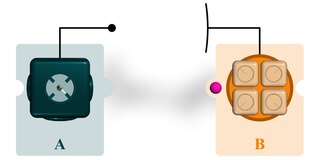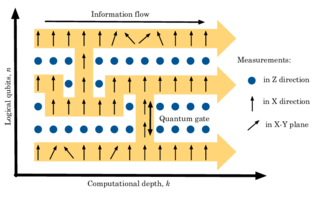
A quantum computer is a computer that takes advantage of quantum mechanical phenomena.

Quantum teleportation is a technique for transferring quantum information from a sender at one location to a receiver some distance away. While teleportation is commonly portrayed in science fiction as a means to transfer physical objects from one location to the next, quantum teleportation only transfers quantum information. The sender does not have to know the particular quantum state being transferred. Moreover, the location of the recipient can be unknown, but to complete the quantum teleportation, classical information needs to be sent from sender to receiver. Because classical information needs to be sent, quantum teleportation cannot occur faster than the speed of light.

In quantum computing, a qubit or quantum bit is a basic unit of quantum information—the quantum version of the classic binary bit physically realized with a two-state device. A qubit is a two-state quantum-mechanical system, one of the simplest quantum systems displaying the peculiarity of quantum mechanics. Examples include the spin of the electron in which the two levels can be taken as spin up and spin down; or the polarization of a single photon in which the two states can be taken to be the vertical polarization and the horizontal polarization. In a classical system, a bit would have to be in one state or the other. However, quantum mechanics allows the qubit to be in a coherent superposition of both states simultaneously, a property that is fundamental to quantum mechanics and quantum computing.
In logic circuits, the Toffoli gate, invented by Tommaso Toffoli, is a universal reversible logic gate, which means that any classical reversible circuit can be constructed from Toffoli gates. It is also known as the "controlled-controlled-not" gate, which describes its action. It has 3-bit inputs and outputs; if the first two bits are both set to 1, it inverts the third bit, otherwise all bits stay the same.

A trapped-ion quantum computer is one proposed approach to a large-scale quantum computer. Ions, or charged atomic particles, can be confined and suspended in free space using electromagnetic fields. Qubits are stored in stable electronic states of each ion, and quantum information can be transferred through the collective quantized motion of the ions in a shared trap. Lasers are applied to induce coupling between the qubit states or coupling between the internal qubit states and the external motional states.

In computer science, the controlled NOT gate, controlled-X gate, controlled-bit-flip gate, Feynman gate or controlled Pauli-X is a quantum logic gate that is an essential component in the construction of a gate-based quantum computer. It can be used to entangle and disentangle Bell states. Any quantum circuit can be simulated to an arbitrary degree of accuracy using a combination of CNOT gates and single qubit rotations. The gate is sometimes named after Richard Feynman who developed an early notation for quantum gate diagrams in 1986.
In quantum computing, the Gottesman–Knill theorem is a theoretical result by Daniel Gottesman and Emanuel Knill that states that stabilizer circuits, circuits that only consist of gates from the normalizer of the qubit Pauli group, also called Clifford group, can be perfectly simulated in polynomial time on a probabilistic classical computer. The Clifford group can be generated solely by using CNOT, Hadamard, and phase gate S; and therefore stabilizer circuits can be constructed using only these gates.
Quantum cloning is a process that takes an arbitrary, unknown quantum state and makes an exact copy without altering the original state in any way. Quantum cloning is forbidden by the laws of quantum mechanics as shown by the no cloning theorem, which states that there is no operation for cloning any arbitrary state perfectly. In Dirac notation, the process of quantum cloning is described by:

The one-way or measurement-based quantum computer (MBQC) is a method of quantum computing that first prepares an entangled resource state, usually a cluster state or graph state, then performs single qubit measurements on it. It is "one-way" because the resource state is destroyed by the measurements.
In quantum computing, the threshold theorem states that a quantum computer with a physical error rate below a certain threshold can, through application of quantum error correction schemes, suppress the logical error rate to arbitrarily low levels. This shows that quantum computers can be made fault-tolerant, as an analogue to von Neumann's threshold theorem for classical computation. This result was proven by the groups of Dorit Aharanov and Michael Ben-Or; Emanuel Knill, Raymond Laflamme, and Wojciech Zurek; and Alexei Kitaev independently. These results built off a paper of Peter Shor, which proved a weaker version of the threshold theorem.
Linear optical quantum computing or linear optics quantum computation (LOQC) is a paradigm of quantum computation, allowing universal quantum computation. LOQC uses photons as information carriers, mainly uses linear optical elements, or optical instruments to process quantum information, and uses photon detectors and quantum memories to detect and store quantum information.
The DiVincenzo criteria are conditions necessary for constructing a quantum computer, conditions proposed in 2000 by the theoretical physicist David P. DiVincenzo, as being those necessary to construct such a computer—a computer first proposed by mathematician Yuri Manin, in 1980, and physicist Richard Feynman, in 1982—as a means to efficiently simulate quantum systems, such as in solving the quantum many-body problem.
The KLM scheme or KLM protocol is an implementation of linear optical quantum computing (LOQC), developed in 2000 by Emanuel Knill, Raymond Laflamme and Gerard J. Milburn. This protocol makes it possible to create universal quantum computers solely with linear optical tools. The KLM protocol uses linear optical elements, single-photon sources and photon detectors as resources to construct a quantum computation scheme involving only ancilla resources, quantum teleportations and error corrections.
Continuous-variable (CV) quantum information is the area of quantum information science that makes use of physical observables, like the strength of an electromagnetic field, whose numerical values belong to continuous intervals. One primary application is quantum computing. In a sense, continuous-variable quantum computation is "analog", while quantum computation using qubits is "digital." In more technical terms, the former makes use of Hilbert spaces that are infinite-dimensional, while the Hilbert spaces for systems comprising collections of qubits are finite-dimensional. One motivation for studying continuous-variable quantum computation is to understand what resources are necessary to make quantum computers more powerful than classical ones.
Optical cluster states are a proposed tool to achieve quantum computational universality in linear optical quantum computing (LOQC). As direct entangling operations with photons often require nonlinear effects, probabilistic generation of entangled resource states has been proposed as an alternative path to the direct approach.
In quantum computing, a qubit is a unit of information analogous to a bit in classical computing, but it is affected by quantum mechanical properties such as superposition and entanglement which allow qubits to be in some ways more powerful than classical bits for some tasks. Qubits are used in quantum circuits and quantum algorithms composed of quantum logic gates to solve computational problems, where they are used for input/output and intermediate computations.
Magic state distillation is a method for creating more accurate quantum states from multiple noisy ones, which is important for building fault tolerant quantum computers. It has also been linked to quantum contextuality, a concept thought to contribute to quantum computers' power.
In quantum computing and quantum information theory, the Clifford gates are the elements of the Clifford group, a set of mathematical transformations which normalize the n-qubit Pauli group, i.e., map tensor products of Pauli matrices to tensor products of Pauli matrices through conjugation. The notion was introduced by Daniel Gottesman and is named after the mathematician William Kingdon Clifford. Quantum circuits that consist of only Clifford gates can be efficiently simulated with a classical computer due to the Gottesman–Knill theorem.
The Eastin–Knill theorem is a no-go theorem that states: "No quantum error correcting code can have a continuous symmetry which acts transversely on physical qubits". In other words, no quantum error correcting code can transversely implement a universal gate set, where a transversal logical gate is one that can be implemented on a logical qubit by the independent action of separate physical gates on corresponding physical qubits.
This glossary of quantum computing is a list of definitions of terms and concepts used in quantum computing, its sub-disciplines, and related fields.






